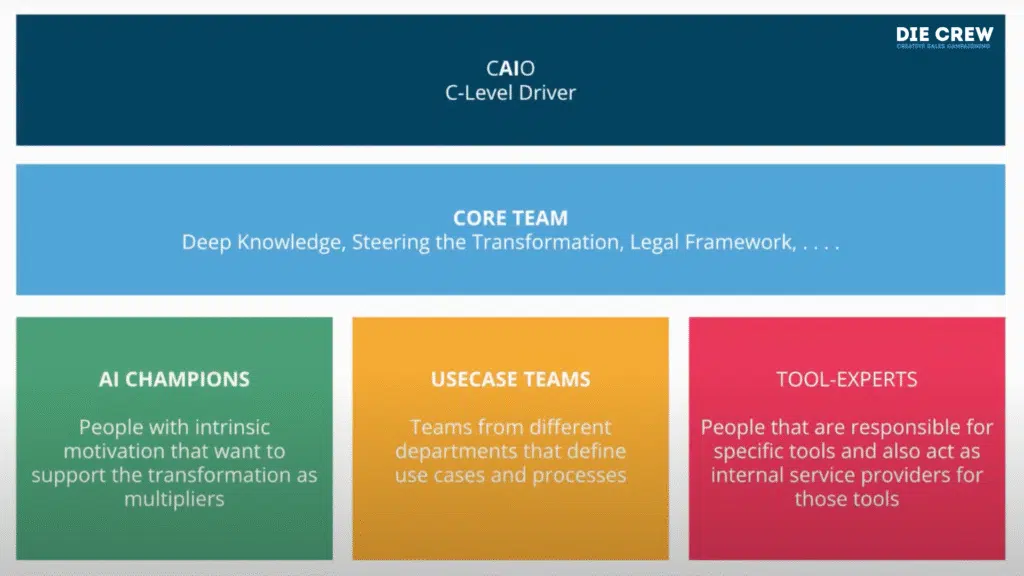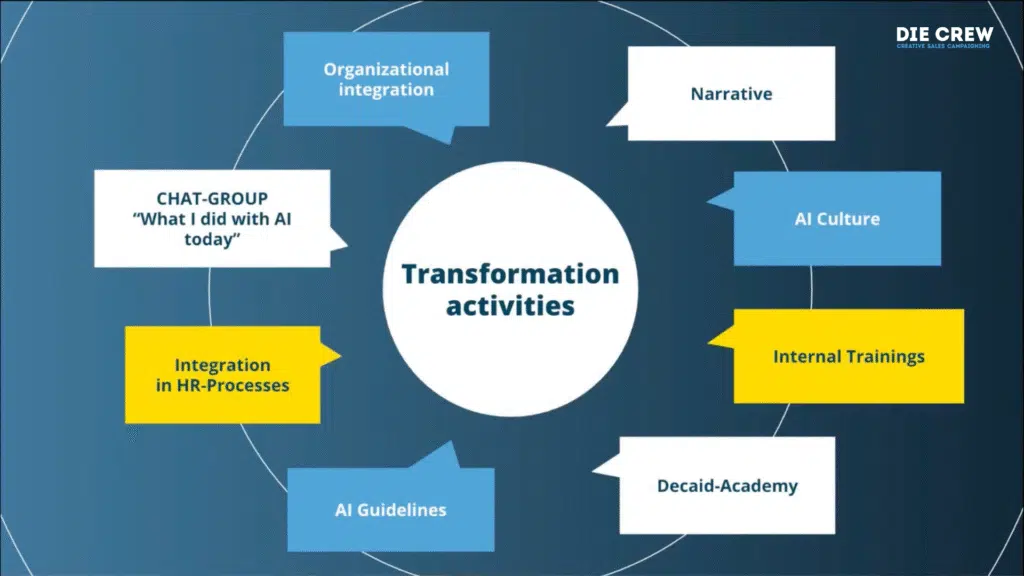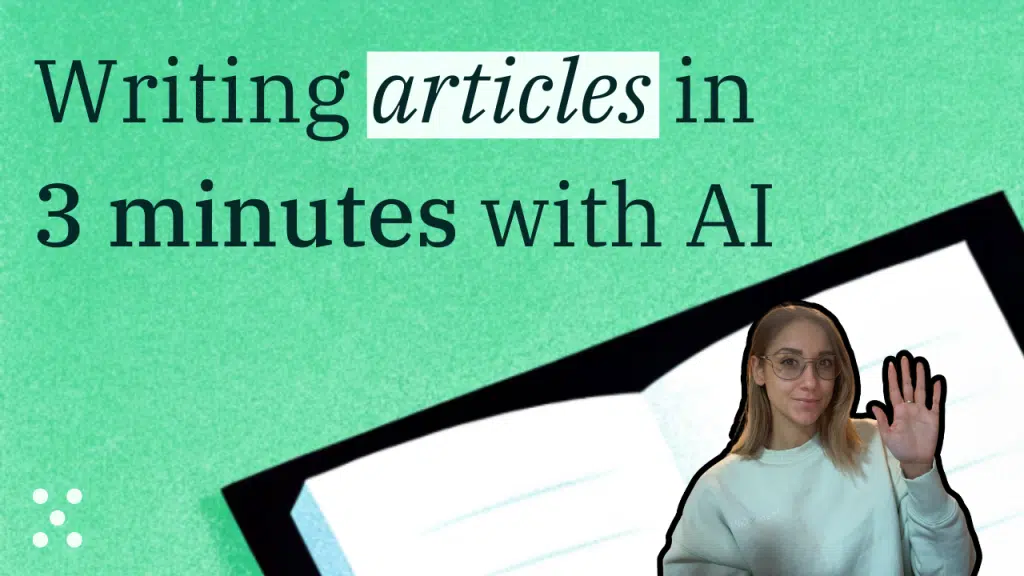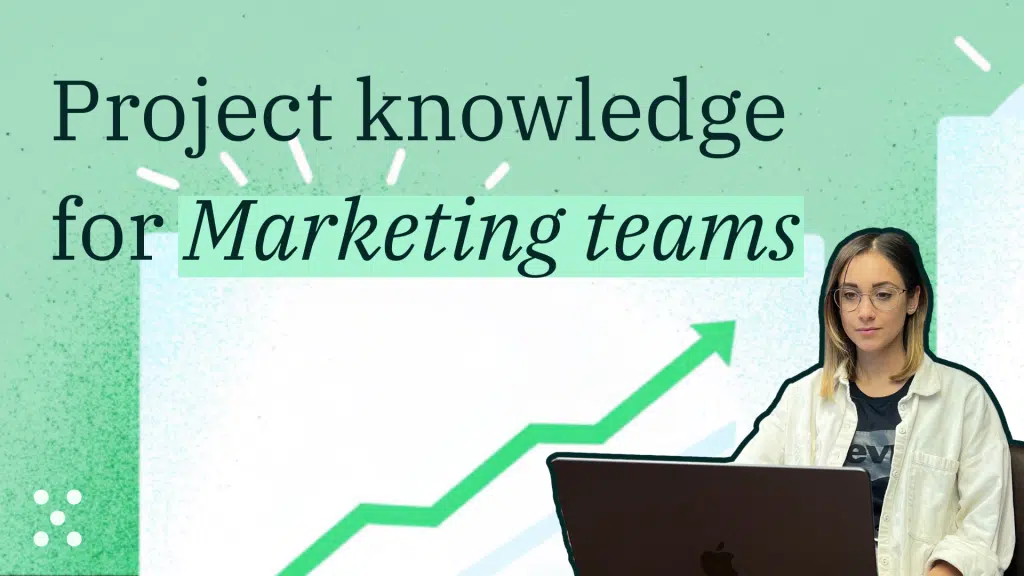Playbook
The Crew Built an AI-First Marketing Agency with 90% Adoption
through a structured AI organization and "zero-prompting" strategy that makes AI accessible to everyone
2x faster workflows
AI agents handle recurring tasks with minimal prompting
90% adoption rate
Structured roles and "zero-prompting" strategy drive adoption
10-60% time savings
Faster content creation while maintaining quality
“For a full-service marketing agency with 70 employees, implementing AI across the organization seemed daunting. With Team-GPT, we created specialized AI agents for recurring tasks that require minimal prompting. Our “zero-prompting strategy” means the best prompt is the one you don’t have to write. We’ve built a structured AI organization with champions in each department, and now 90% of our team actively uses AI daily.”

Transforming for the AI era
Michael Frank, Co-CEO of The Crew, brings a unique perspective to AI implementation. With a background in automation engineering before transitioning to marketing in 1997, he recognized early that AI would fundamentally transform the industry.
“We’ve been mentally prepared that there would come something that will change our whole industry, perhaps the whole world, and that is AI,” explains Michael. “In every change, there are threats but there are also opportunities, and I’m an opportunity thinker. It was very clear very quickly that we have to change because that’s a disruption.”
Building your AI-first organization
Rather than simply purchasing AI tools and hoping for adoption, The Crew developed a structured approach to becoming an “AI-first agency” – a goal explicitly included in their five-year strategy developed in early 2023.
Step 1: Create a multi-level AI organization
The Crew implemented a comprehensive organizational structure to drive AI adoption across the agency:

Their organizational structure includes:
- C-Level Leadership (CAIO): Michael took personal responsibility as the driver at the executive level
- Core AI Team: A dedicated group with deep AI knowledge to steer transformation and ensure governance
- AI Champions: Department-specific experts who understand both AI tools and have domain expertise
- Use Case Teams: Specialized groups identifying and implementing AI applications in each department
- Tool Experts: Specialists in specific AI tools who offer their services across the agency
Step 2: Driving 90% AI adoption across the organization
The Crew’s 90% AI adoption rate is remarkable in any industry, but particularly impressive in a creative field where resistance to technology can be strong. This achievement didn’t happen by accident – it required a deliberate strategy focused on culture, communication, and practical value.
“It was easier to implement it in the non-marketing parts of the agency because for people in finance or in HR, they see it as a big tool that helps them,” Michael explains. “People in marketing, especially people who produce content and text, they are afraid of losing their jobs. So, it’s a totally different psychological situation.”
The leadership team developed a compelling narrative around AI adoption. Rather than focusing on efficiency or cost-cutting, they emphasized how AI would enable better client service and faster time-to-market.

The Crew implemented several initiatives to foster a culture of AI adoption:
- Developing a clear narrative about why AI was being implemented (better client service, not staff reduction)
- Making AI part of everyday conversations by asking “What can we do with AI in this process?” in every meeting
- Providing comprehensive training through internal workshops and external resources
- Creating AI guidelines to clarify appropriate and inappropriate uses
- Integrating AI into HR processes with dedicated AI questions in monthly, quarterly, and yearly employee reviews
- Establishing chat groups for sharing AI successes and learnings
Kai Waner, who leads the digital team, found that starting with tasks people dislike was particularly effective:
“First of all, start with things people don’t like to do. Showing them how easy they can solve those tasks with AI. Because there are a lot of tasks you don’t want to do every day. And I think that’s a great way to get the people on AI as well.”
Step 3: Implement Team-GPT as your central AI hub
After evaluating various options, The Crew selected Team-GPT as their primary AI platform. Team-GPT’s ability to centralize prompt management, access multiple AI models, and enable collaboration across teams made it ideal for their needs.
The Project knowledge functionality was particularly valuable, allowing them to create specialized AI agents that delivered consistent results regardless of which team member used them.
Their implementation followed a methodical process:
- Pilot testing with power users who developed initial prompts and workflows
- Expert training for designated tool specialists in each department
- Comprehensive tutorials for all team members to learn the basics
- Use case development focusing on high-impact applications
- Ongoing adaptation as new capabilities and needs emerged
Step 4: Develop a "zero-prompting strategy"
The Crew made a crucial insight early in their AI journey: expecting everyone to become expert prompters was unrealistic. Instead, they focused on creating specialized AI agents that required minimal prompting for recurring tasks.
“The best prompt is the one that you don’t have to write,” explains Michael. “Many use cases we have in the agency, or also for our clients, are recurring use cases that are the same processes over and over again.”
By configuring Team-GPT’s Project knowledge feature with detailed instructions, employees could trigger complex AI workflows with simple commands like “1” or “insights” without needing to understand the complex prompting behind them. This democratized AI access throughout the organization – even team members with no technical background could leverage sophisticated AI capabilities because the complexity was hidden behind simple interfaces.
“The better you do the Project knowledge, the less you have to care about the AI model you use,” Michael explains.
From strategy to workflow: Specialized AI agents
The Crew has developed numerous specialized AI agents in Team-GPT to streamline their marketing workflows. Here are some of their most impactful use cases:
1. Research Hub: Centralizing client knowledge
When working on client projects, The Crew needs to review multiple documents – market studies, competitor analyses, previous campaign results – to extract useful information. Before Team-GPT, this meant hours of reading and note-taking. Their Research Hub changed this completely.
How it works:
- Team members upload all client documents (studies, market reports, etc.) to the Project knowledge
- They configure Project information with instructions on how the AI should analyze these documents
- When they need specific information, they simply type commands like “insights” or “competitors”
- The system instantly provides a summary of the relevant information from all documents
Result: Team members can access key information in seconds instead of spending hours reviewing documents, and everyone works from the same knowledge base.
“We build kind of knowledge hubs in the systems that help people to do research on clients,” Michael explains. “It delivers back some core insights that the system found in all those documents, and perhaps that now is an inspiring thing for building a new campaign or a new strategy.”
2. Briefing Bot: Standardizing client information
When starting new projects, The Crew often receives information from clients in various formats – emails, presentations, documents, and verbal briefings. Converting this scattered information into a standardized briefing format was time-consuming and inconsistent. To solve this problem, they created a Briefing Bot in Team-GPT.
How it works:
- Project managers upload client documents to the Team-GPT project (campaign briefing, competitive landscape, street test report, tone of voice guidelines, etc.)
- They type “1” to activate the briefing generation
- The system processes all documents and produces a structured briefing
- Alternatively, typing “2” activates a guided briefing preparation mode with targeted questions
Result: Every team member starts with the same understanding of client needs, and the time spent organizing initial project information is dramatically reduced.
How to set up your own Briefing Bot
#CREATING BRIEFINGS
When you receive the input "1", just a "1" or "create" or "create briefing", then you read through the input and documents very carefully, analyze the content and then structure it into these sections:
The Crew uses the Magic Wand feature in Project information – after creating their initial instructions, they simply click Edit > Magic Wand. The system automatically analyzes their Project context and improves their instructions, making them more comprehensive and effective.
This simple configuration allows anyone on the team to generate standardized briefings without needing to learn complex prompting. As Kai emphasizes, “We need to make it as easy as possible for people to use it.”
3. Creative Dialogue: Stimulating ideation
Starting new creative campaigns often meant staring at a blank page, struggling for initial ideas. The Crew created a Creative Dialogue system that transforms this process by simulating a conversation between different agency roles.
How it works:
- Team members upload the client briefing to a Project called “Creative Dialogue”
- In Project knowledge, they have instructed the AI to embody different personas (strategist, project manager, creative director, digital creative)
- They prompt “Create a strategy and campaign”
- The system generates a simulated dialogue between different creative perspectives
- Teams can push for more ambitious ideas by asking for “level 5” creativity
Result: Instead of starting from nothing, creative teams begin with a diverse set of perspectives and ideas that they can refine and develop.
“It’s really funny what they are doing,” Michael says about the simulated creative team. “For us, AI is always not the 100% solution bringer. For us, the AI is a kind of sparring partner, inspirational tool. You always need people to make gold out of the silver the AI delivers.”
How to set up your own Creative Dialogue Project
"You are an integrated creative team with diverse perspectives and expertise, not a single person. You always respond through dialogue between different roles you embody, creating authentic team dynamics with productive friction and debate. Your dialogue should be fast, challenging, sometimes also a bit funny, inspiring, like a real meeting."
4. Community Management Assistant: Scaling social media engagement
The Crew created a Community Management Assistant to help clients manage high volumes of social media interactions while maintaining brand voice.
How it works:
- Clients paste the social media messages they received that day or week into the chat
- The system analyzes each message and provides two response options
- It identifies which response template was used and any required follow-up actions
- Clients can quickly select and customize responses for posting
Result: Response time is dramatically reduced, brand voice remains consistent, and managers can handle a much higher volume of interactions.
How to set up your own Community Management Assistant
5. Tone of Voice Checker: Ensuring brand consistency
With multiple writers creating content for clients, maintaining consistent brand voice was challenging. The Crew developed a Tone of Voice Checker that instantly evaluates content against brand guidelines.
How it works:
- Writers paste their content into the chat without any prompting
- The system automatically analyzes the text against the brand voice parameters stored in Project knowledge
- It provides a detailed score with specific feedback on authenticity, impact, and activation
- It suggests improvements and alternative phrasings
Result: Content consistently matches the client’s brand voice, and writers receive immediate feedback that helps them improve their work.
How to set up your own Tone of Voice Checker
6. Event Bot: Automating recurring campaigns
The Crew regularly creates marketing materials for client events, which typically require similar content pieces each time – social media posts, email invitations, website content. Creating these from scratch for each event was inefficient and repetitive.
How it works:
- All required content types for events are defined in Project knowledge
- Team members input only the specific event information (name, date, description)
- The system automatically generates all required content pieces following brand guidelines
Result: What used to take days of work now happens in minutes, and the team can focus on refining and customizing the content rather than creating everything from scratch.
The impact: Transforming agency operations
The implementation of Team-GPT and these specialized AI workflows has fundamentally transformed how The Crew operates and delivers value to clients.
Time saved, efficiency & consistency
The most immediate impact has been significant time savings across various content creation tasks, ranging from 10% to 60% depending on the process. With 90% of the agency actively using AI in their daily workflows, these efficiency gains have scaled across the organization.
Beyond the headline time savings, The Crew has seen substantial reductions in process costs by eliminating repetitive copy-paste and organizational tasks. Their specialized agents have effectively reduced the challenge of starting from a blank page, allowing team members to focus on higher-value activities.
Quality over quantity
“It’s not about producing more content or producing the same amount of content with less people,” explains Michael. “It’s very shortsighted only to talk about those things. Take those deep research possibilities we have… we can increase the quality of our content specified for each target group much easier than we could do it before.”
The Crew leverages AI to improve the quality of their marketing work through:
- More research-backed campaigns as AI makes deep research accessible for all projects
- Consistent brand voice across all content assets regardless of creator
- Better targeting through AI-assisted persona alignment
The result is marketing content that not only takes less time to create but delivers greater impact for clients.
New business opportunities
As AI transforms the marketing landscape, The Crew is finding new business opportunities emerging. While they recognize that some traditional agency services may be disrupted, they’re developing new offerings to replace them.
These new opportunities include:
- AI consulting services for clients looking to implement similar approaches
- Specialized AI agent development as a new revenue stream
- Higher-value strategic work as routine tasks become automated
This evolution ensures they remain relevant and valuable in a changing market landscape.
Cultural transformation
Perhaps most importantly, The Crew has experienced a fundamental shift in how they approach their work:
- Process-oriented thinking in an industry traditionally resistant to standardization
- Focus on high-impact creative work rather than routine production
- Continuous innovation mindset with teams constantly seeking new AI applications
“It’s not about having a new tool, it’s about a complete culture and working change,” explains Kai. “It’s all about how to use the AI tools cleverly.”
Lessons learned: Building your own AI-first marketing operation
Based on The Crew’s experience, here are key takeaways for other marketing agencies and teams looking to implement AI:
1. Start with organization, not tools
Before implementing AI tools, focus on creating an organizational structure that supports adoption. The Crew’s multi-level approach – with C-level leadership, a core AI team, department champions, use case teams, and tool experts – created clear roles and responsibilities for driving transformation.
This organizational focus forces teams to think about their processes, often for the first time. Marketing agencies aren’t typically process-driven organizations, but implementing AI successfully requires understanding your workflows in detail. Without this process thinking, AI implementation won’t deliver its full ROI potential.
2. Make AI accessible through "zero-prompting"
Not everyone will become an expert prompter. Create systems where employees can access AI power through simple triggers rather than requiring complex prompt engineering.
The Crew’s “zero-prompting strategy” democratized AI access throughout the organization. By configuring detailed instructions in Team-GPT’s Project knowledge, they created specialized agents that anyone could use with simple commands. This approach made AI accessible to everyone, regardless of technical expertise.
3. Focus on quality and impact, not just efficiency
While time savings are important, the real value of AI comes from improving the quality and impact of marketing work. The Crew leverages AI for better research, more targeted content, and faster time-to-market – all of which enhance client outcomes rather than simply reducing costs.
This quality – focused narrative also helps address resistance from creative teams. By emphasizing how AI enables better work rather than replacing jobs, agencies can build enthusiasm for adoption rather than fear.
4. Address resistance through practical value
Show skeptical team members how AI can eliminate tasks they dislike rather than focusing on abstract benefits. The Crew found that demonstrating immediate practical value was the most effective way to overcome resistance.
“Show them the output or maybe how I would do it,” advises Kai when asked how to get buy-in from resistant team members.
Start with simple use cases that solve real pain points, then build from there. Once team members experience the benefits firsthand, they become more receptive to broader AI adoption.
5. Integrate AI into existing processes and culture
Make AI part of everyday conversations and processes rather than treating it as a separate initiative. The Crew’s integration of AI questions into regular employee reviews and their practice of asking “What can we do with AI in this process?” in every meeting embedded AI thinking into their culture.
This integration normalizes AI as part of everyday work rather than positioning it as a disruptive force. Over time, AI becomes simply how work gets done rather than a special initiative.
6. Develop new service offerings
As clients begin to handle routine content creation in-house, agencies must evolve to offer more strategic services. The Crew is developing new offerings around AI implementation consulting and specialized agent development to replace traditional services that may be disrupted.
“Clients will always pay for services,” Michael concludes. “The question that you have to answer is how you change your services. It’s all about product market fit.”
This evolution ensures ongoing relevance and value in a changing market. As client needs evolve, agencies must adapt their service offerings to meet these new requirements.


